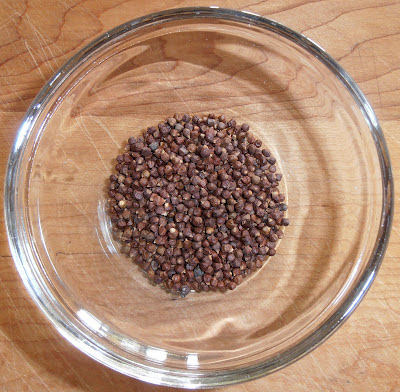A capon is a "male chicken castrated when young to improve the quality of its flesh for food." (www.thefreedictionary.com/capon)
The receipt came from The Good Housewife's Jewel, by Thomas Dawson, originally published around 1596.
 |
| Published by Southover Press, 1996 |
The directions are as follows (page 13):
Take oranges or lemons peeled, and cut them the long way. If you can keep your cloves whole put them into your best broth of mutton or capon, with prunes or currants and three or four dates. When these have been well sodden put whole pepper, great mace, a good piece of sugar, some rose water and either white or claret wine. And let all these seethe together a while. And so serve it upon sops with your capon.
Did you notice that he never says when to put in the capon? I assumed it was in the beginning with the broth, citrus, cloves, prunes, currants, and dates. Note that I used lemons, I didn't have any dates, and I have no idea if my chicken was a capon or not. I didn't ask it... or check it or even really care. Our modern birds are bred to be tender and we don't need to go out of our way to get a capon.
 |
| Chicken, lemons, cloves, currants, and prunes |
 |
| And then with the broth |
I deemed the mix "well sodden" after it had simmered gently for about an hour. Then I added the Grains of Paradise (a black pepper substitute, ground), mace, sugar (about 2 tablespoons), some orange water because I had no rose water (just a splash), and a few cups of white wine. For all of the spices I just guessed at the amount and can't really tell you how much that was. Certainly no more than a teaspoon of any type, keeping in mind that I wasn't that familiar with the strength of the Grains of Paradise and I didn't want to over-spice the broth.
 |
| Here it is all together |
Here is what the chicken looked like when I pulled it out of the broth. I think it looks over-cooked although it was certainly tender.
It looked nice sliced on the platter with some parsley and a few of the currants:
My overall impression was that the meat was over-cooked. Not dry but not as flavorful as I wanted and had that sort of mealy texture. However my dinner guests did not agree with me and said it tasted great.
The Verdict: Success? It made a nice main course for dinner with the slices served over toast (called "sops") and some of the juice it was cooked in spooned over that. (The sops soak up some of the juice.)
I'm not giving this a complete success rating because I felt it was cooked too long. That didn't stop me from eating it, though!
This requires another test drive, I believe.








